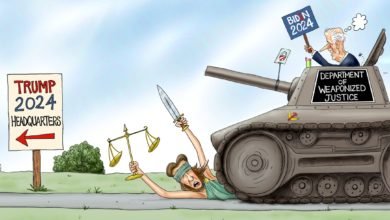Biden’s ‘Stimulus’ Bill Favored Blue States in One Huge Way, New Study Finds
President Biden’s multi-trillion-dollar “American Rescue Plan” was supposed to be a COVID-19 relief bill. But in reality, 90 percent of the money spent wasn’t used to directly address the coronavirus. And the bill included a massive $350 billion federal bailout for state and local governments despite them not actually experiencing a pandemic-induced revenue shortage.
This inclusion was puzzling from a policymaking perspective. But we now have some insight as to what may have motivated the unneeded state bailout: partisan politics.
A new study by economists Jeffrey Clemens and Stan Veuger examined the distribution of COVID-19 stimulus funds relative to changing political representation in the federal government. It finds that the first several pieces of stimulus legislation passed under former President Trump and a divided Congress did not favor states based on partisan affiliation, but did have a bias in favor of small states. (Likely due to their extra representation in the Senate relative to their population).
But here’s the big reveal. After President Biden took office and Democrats gained control of both branches of Congress, the next stimulus bill, the aforementioned American Rescue Plan, had a strong blue-state bias in its funding allocation.
“Alignment with the Democratic party predicts increases in states’ allocations through legislation designed after the January 2021 political transition,” the study concludes. “This benefit of partisan alignment operates through the American Rescue Plan Act’s sheer size, as well as the formulas through which it distributed transportation and general relief funds.”
We’re not talking about chump change, either. The economists find that states with Democratic congressional delegations came away with $300 more per person in federal money in Biden’s bill than they did in past legislation under a divided government.
Now, this wasn’t necessarily an overt or conscious act of partisan corruption. The discrepancy comes because policymakers changed the funding formula, switching from the population-based allocation used in earlier legislation to allocation based on state-level unemployment rates.
This isn’t necessarily an outrageous thing to do, but it is highly questionable because it forces federal taxpayers to subsidize the political choices of heavy-lockdown states (which tended to be governed by Democrats). And there’s simply no doubt that the skew in benefits toward their own states made the unemployment-based funding formula more attractive to the politicians behind Biden’s stimulus legislation—at the very least, implicitly and subconsciously so.
The takeaway here isn’t that we have some sort of newfangled, massive corruption scandal. Rather, it’s that this kind of stuff happens all the time. Whenever you entrust politicians (who tend to be a less than scrupulous sort) with doling out literal trillions of dollars, bias and favoritism are sure to ensue.
As famed free-market economist Ludwig von Mises said, “There is no such thing as a just and fair method of exercising the tremendous power that interventionism puts into the hands of the legislature and the executive. In many fields of the administration of interventionist measures, favoritism simply cannot be avoided.”
If we needed any more proof that Mises was right, well, the big-spending politicians in Washington, DC just handed it to us.
Like this story? Click here to sign up for the FEE Daily and get free-market news and analysis like this from Policy Correspondent Brad Polumbo in your inbox every weekday.
This article was originally published on FEE.org




